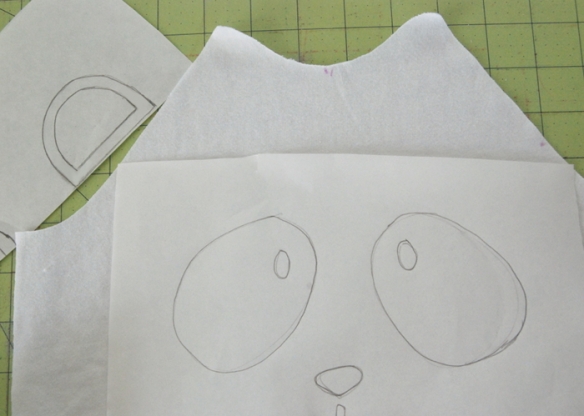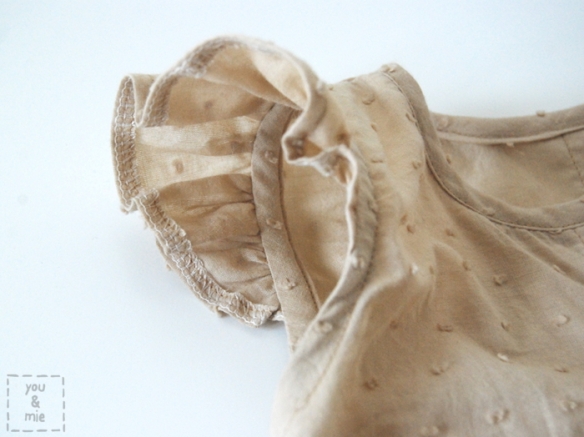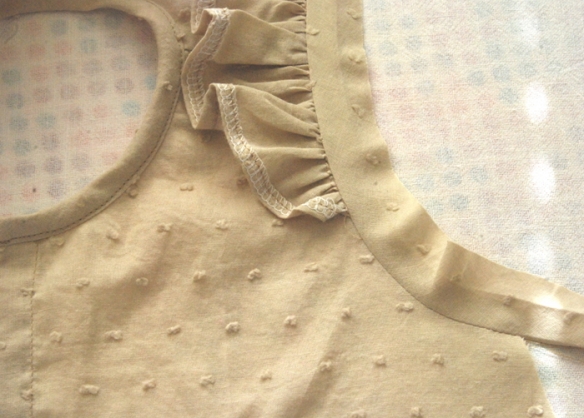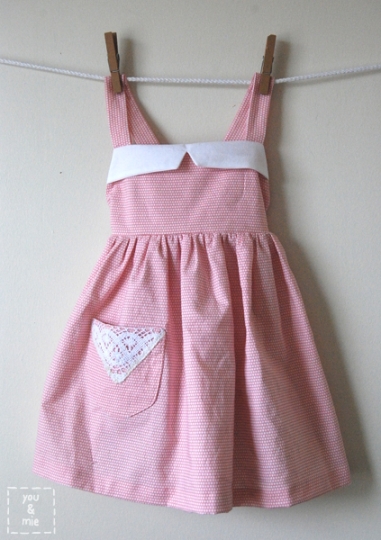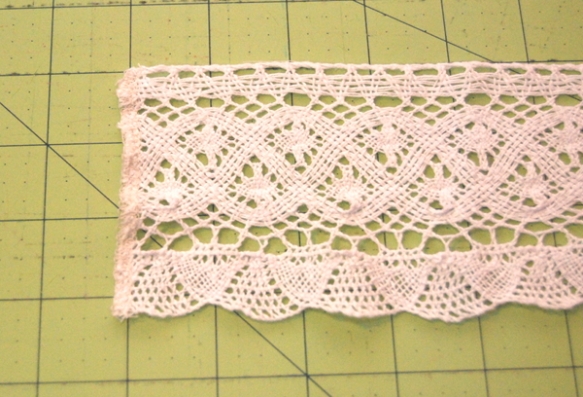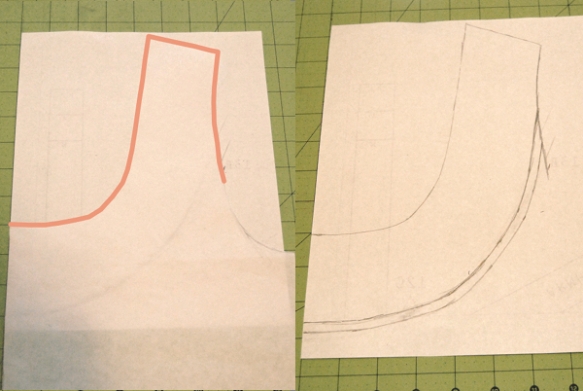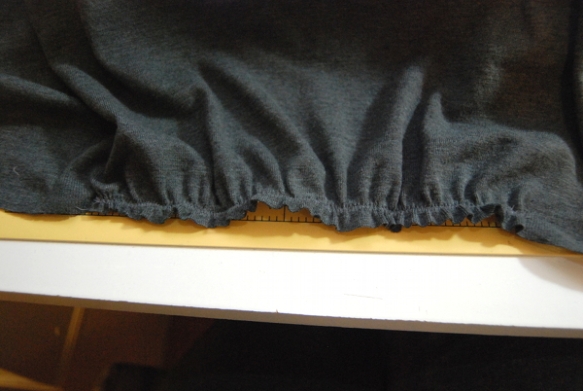
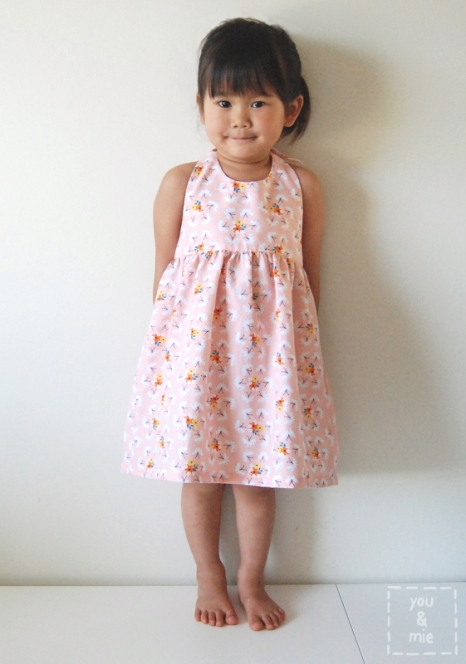
I’m so excited to be posting as part of Melly Sews’ (30) Days of Sundresses Series for the THIRD time (see my previous tutorials here and here)! A new sundress tutorial every day this month! Keep up with them all on Melly Sews.

I’m pretty excited about sharing this project because it was one of those things that I had a vision of, but didn’t know if or how it’d work. But then it ended up exactly how I pictured it and I’m thrilled!


The dress is a halter-style dress with two ties in the back, a skirt that is gathered in the front and elastic in the back and, of course, pockets. It’s super summery and perfect for the beach or picnics or parties, or whatever else you’ll be up to this season! Just be sure to slather on the sunscreen because this baby shows a lot of back (but not that kind of back).

This is currently Yuki’s favorite dress and she requests to wear it as often as possible. We’ve also gotten tons of compliments on it, which is due in great part to the adorable fabric. It’s part of Cloud9’s Lotus Pond Collection by Rae Hoekstra and it’s called Fluttering Fields, which is where I got the name of the dress (thanks Rae)! I love this fabric – high quality, organic, lovely to sew and lovely to wear (I basically live in my Lotus Pond pajama pants).

Here is Yuki cracking herself up after sticking her tongue out at me. She thinks she’s hilarious . . . 😛
Do you want to make a Fluttering Fields Sundress!? It’s really not very difficult at all! Full disclosure here though – when I sew, I kind of make things up as I go and hope it comes out ok. I often make changes along the way and later wish I did things differently or wonder if I did them the “right” way. Luckily, things worked out pretty well with this project, but it certainly isn’t perfect and I’m going to tell you what things I discovered along the way or would do differently if I were to do it again. It’s all about learning here, right?
Ok, here’s what you need:
- Fabric (1-2 yards depending on the size)
- Basic front bodice pattern
- 1/4 inch wide elastic
For your fabric, I recommend a light to mid-weight woven fabric like quilting cotton, shirting, chambray, linen blend, double gauze, etc. I’m pretty sure you could even use a stable knit, but I haven’t tried.
I started from a basic bodice pattern that I already had (from the Geranium Dress), but you can also draft your own from a shirt or dress that fits your child or use a different dress bodice pattern.

Taking your front bodice pattern piece as a starting point, I’m going to show you the edits I made to form the new bodice pattern for this halter style dress. Some of this will depend on personal preference and the specific bodice pattern you’re starting with though.

First I dropped the neckline slightly and created a new curve to meet the original neckline.
Now here is where what I did and what I wish I did start to differ. I lowered the bottom of the armhole by about 1/2 an inch. In hindsight, I probably didn’t need to do that. What you need to know here is that whatever the measurement of the side of your bodice is (marked in turquoise), is going to be the width of your ties plus your seam allowance.
Mistake #2: I used a 1/4 inch seam allowance, which works out fine, but I do find it easier to work with at least 3/8 of an inch seam allowance. So in all the pictures and directions, I’ll refer to a 1/4 inch seam allowance, but at the pattern drafting stage, I recommend you work in a larger seam allowance. It’ll make the construction a little easier and when you construct yours, remember to substitute your seam allowance measurement whenever I say a 1/4 inch. Got it?
So measure down about 2 inches from your armhole and if you need to shorten your bodice, do so. The Geranium bodice is quite short as is, so I didn’t adjust the length.
That measurement you took (the turquoise line), that is going to be the same as your shoulder seam measurement (magenta line). It just makes it easy to have all of your ties be the same width. Rather than angling down, the shoulder seam needs to angle up so that your neck ties will point inwards. Make a slightly curved line from the outer tip of your shoulder to the bottom of the armhole to create a halter shaped bodice. The other thing I would change here is the depth of this curve. You can see in the finished dress that the bodice cuts in quite a bit, so if you want more coverage, make the line straighter.
Phew! Are you still with me? Trust me, that was the hardest part!

Next, we need to create the pattern for the ties. You will use the same tie pattern piece for both the neck ties and the back ties. In my second version of this dress, I followed the formula, but the back ties were too short. I’m updating the directions, but I haven’t tested it out yet. If I make a third dress, I’ll let you know if this works.
To determine the length of the neck ties, I calculated 3/4 of the total bodice width. To do that, first measure the bottom edge of your bodice pattern then multiply that in two, since that pattern is only half a bodice. For example, say your bodice pattern measures 6 inches across the bottom, that means the entire bodice will measure 12 inches. Take that number and multiply it by .75 to calculate 3/4 of the width. In my case, that is 9 inches.
For the back ties, take the length you just calculated (9 inches, in my case) and add 2 inches. So your neck ties will be 9 inches long and your back ties will be 11 inches long.
*I have not tested this formula with any other sizes than this one, so I can’t guarantee this will be the right length, but I’m fairly certain that it should work.*
The width of your tie pattern will be the same measurement as that turquoise and magenta line up there, somewhere around 2 inches (mine is narrower because of the small SA). Cut out a strip of paper with your measurements, fold it in half lengthwise and taper one end starting 2 inches from the tip. I drew and cut one side, then folded it in half to trace the other side so that it is symmetrical.

Here’s what my pattern pieces looked like. Ignore that middle one because it ended up being too short 😛
Did I tell you that I was working things out as I went along?

Skirt pieces! You’ll need two rectangles for your skirt front and back. To determine the width of a gathered skirt, I usually take the child’s waist measurement and then use that for one skirt panel. For example, if the waist measurement is 20 inches, then my skirt panels will each be 20 inches, for a total of 40 inches, that will then be gathered to just the right amount of fullness (in my opinion). You can add or subtract width according to your preference. The length will depend on the desired length of the dress. Be sure to leave room for seam allowance at the top, hemming at the bottom, and I throw in an extra inch just in case (you’ll need to trim the skirt front to match the back in a later step). Set one of your skirt panels aside.

For the back skirt panel, I added a slight curve along the top edge. Fold your fabric in half (so the side seams are lined up) and cut a subtle curved line from the raw edge (side of the skirt) toward the folded edge, 1 inch down from the top. I wanted to create a slight opening in the back, but knew that the weight of the elastic and fabric would pull the skirt down, so this cut can be very minimal and possibly eliminated altogether.

So here are my cut pieces. You need:
- 2 bodice pieces
- 4 pocket pieces (I just drew this shape to create my own pocket pattern)
- 8 ties
- 2 skirt panels (one rectangle and one with a lowered top edge)
In this lovely picture you can see another X. I accidentally cut my first set of ties too long. I used them anyways, but I would have been better off using a shorter tie (in the pictures, the back ties are triple knotted and still too long for my taste). So ignore the different length tie pieces – all 8 of yours should be the same length.
We’re finally ready to sew!!!
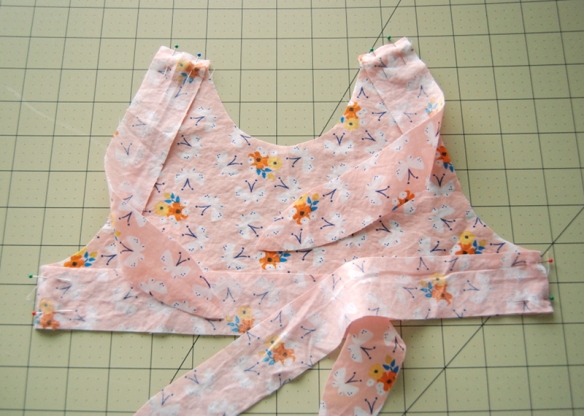
Pin the ties to the bodice sides and shoulders, right sides together.

*VERY IMPORTANT* When you sew the sides, do NOT sew all the way to the bottom. Stop a 1/4 inch from the bottom (If you are using a 3/8 seam allowance, stop 3/8 inch from the bottom). Be sure to back stitch at each end.
Sew shoulder seams all the way across.

Press your seams open.

Your side seams should look like this, with a little opening at the bottom. Repeat with the other bodice and tie pieces.

Place your two bodice pieces with right sides together and pin all the way around starting from the side seam (pink arrow) and going all the way around all four ties and the bodice, back to the other side seam (other pink arrow) and sew. Do not sew the bottom of the bodice during this step.

This is what it should look like, with your stitching beginning and ending at each side seam.

Cut notches in the curved sections of the seam allowance and cut off the excess fabric at the tips of each tie so it will look nice and flat when you turn it right side out.

Turn the bodice and ties right side out (I like to use a mechanical pencil or chopstick to get those ties turned and the tips nice and pointy). Give it a gooooood press. Fold the bottom edge of one of the bodice pieces towards the wrong side by a 1/4 inch (or whatever your seam allowance is) and press. This side is now your bodice lining.

Take your back skirt panel, the one with the curved edge, and create a casing for the elastic by folding it a 1/4 inch and pressing, then 3/8 inch and pressing again. Pin and sew along the folded edge.

To determine your elastic length, take the waist measurement and divide it in half and subtract one inch. So if the waist measurement is 20 inches, divide that in half to get 10 inches, then subtract 1 and your elastic length is 9 inches. You don’t want to err on the side of excess length here. If your elastic is too long then the back of the dress will gape open and hang too low. You want this to be nice and snug against the back.
Thread your elastic through the casing (a safety pin is super helpful here). As the end of the elastic is about to pass through the opening, pin and sew it in place so it doesn’t slip into the casing. Continue to pull the elastic through to the other side and pin and sew it in place. Trim any elastic that is sticking out of the ends of the casing.

If desired, finish the curved edge of each pocket piece. On your front skirt panel, place one pocket, right sides facing, 2 inches down from the top edge. Pin in place. Repeat on the other side.
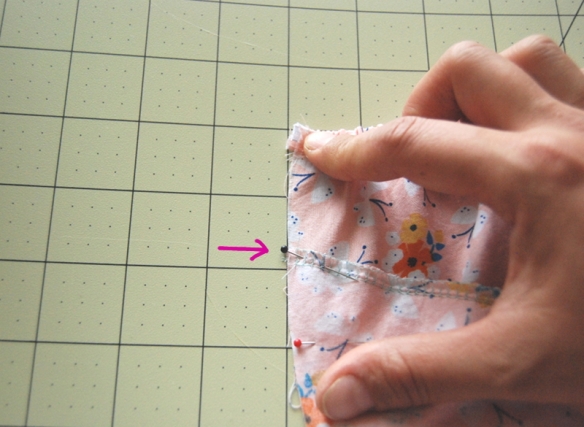
You’ll do the same for the back skirt piece except you’ll place your pocket pieces a 1/4 inch higher (or your seam allowance measurement) lower. So while my front pocket pieces are placed 2 inches from the top, my back pocket pieces are 1 and 3/4 inch from the top.
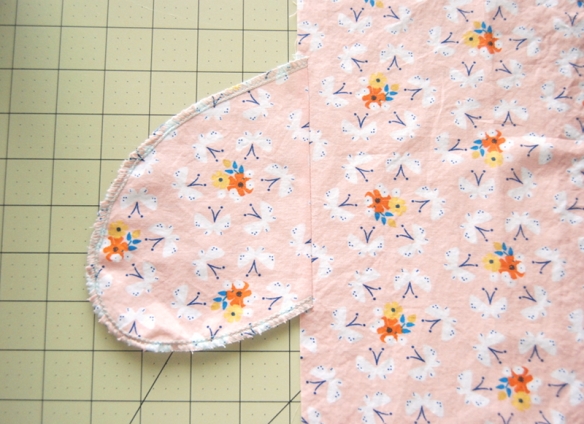
Sew the pocket to the skirt (you can finish the edges of the skirt here if you want) and press the pocket out. Repeat with the other 3 pocket pieces.

Place the skirt front and back right sides together with pockets lined up. The front skirt piece will extend a 1/4 inch higher than the back.

Sew the sides of the skirt together going around the pocket (pink line). Press the side seams toward the front of the dress. Turn right side out and press.

Next we’ll gather the front of the skirt. With a basting stitch (set your stitch length to the longest setting, do not back stitch and leave a tail of thread at the end), stitch two rows along the top edge of the skirt from one side seam to the other. I find that I get the nicest looking gathers when I have one row of basting stitches above the seam allowance line and one below. So I stitched my basting rows about 1/8 inch and 3/8 inch from the top.
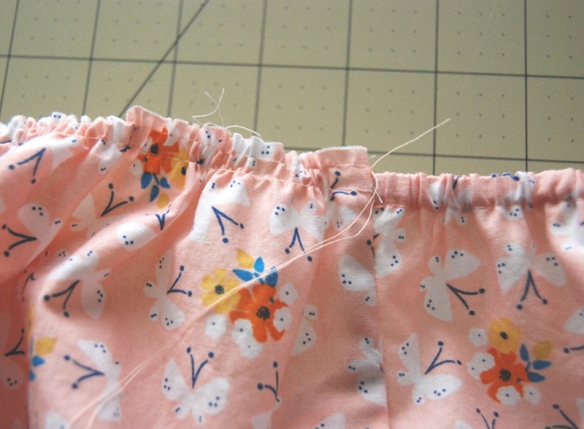
Pull one thread from each row to gather the skirt until it is the same width as the bodice. Distribute the gathers evenly.

Pin the bodice to the gathered front skirt piece, right sides together. Be sure the bodice lining and back of the skirt are pulled aside when you sew. The seam allowance from the sides of the skirt should be folded inwards toward the gathered skirt and will be sewn during this step. Sew bodice and skirt together.

Press bodice and seam allowance up and remove thread from the basting stitches. Woohoo! It’s looking like a dress!

You can attach the bodice lining one of two ways. The first is to hand sew the lining in, enclosing the seam allowance and stitching the lining to only the top layer of fabric. This takes more time, but creates a clean look with no visible stitching.
The second method is to pin the lining down so that it covers the previously stitched line and then, from the right side of the dress, top stitch along the bottom of the bodice. While you’re at it, you can top stitch along the bottom and all the way around the ties and neckline, if you want to. It’s purely up to your personal/aesthetic preference. I opted for the hand sewing.

Now all you need to do is hem! The front of the dress is going to be a little longer than the back because I didn’t take into consideration the difference the casing would make. Yeah, oops again.

Even out the lengths and fold twice towards the wrong side to your desired length and sew along the folded edge. And you’re DOOOOONE!!


Gahhhh! Love this little sun-kissed back!
Yuki’s worn this dress a bunch already and I’ve had to wash it a few times. The only problem is that the ends of the ties have come out of the wash wrinkled, but luckily it’s just that part of the dress and it’s very easy to press (it takes one minute).
I realize that this tutorial is long and possibly hard to follow along, so if you have any questions, feel free to leave me a comment and I’ll do my best to help you! I really hope that some of you give this a try because I’d LOOOOVE to see your versions! Be sure to share them with me via email or load your pictures into the you & mie flickr pool!
Thanks so much for stopping by and be sure to check in at Melly Sews for a new sundress tutorial every day of this month!



















































